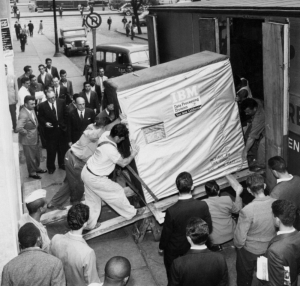December 17, 2017
[liveblog] Maarit Rossi on teaching math that matters
I’m at the STEAM ed Finland conference in Jyväskylä. Maarit Rossi, who teaches math teaching around the world, is talking on the topic: “AI forces us to change maths education.”
|
NOTE: Live-blogging. Getting things wrong. Missing points. Omitting key information. Introducing artificial choppiness. Over-emphasizing small matters. Paraphrasing badly. Not running a spellpchecker. Mangling other people’s ideas and words. You are warned, people. |
Finnish teachers are doing a great, great job, she says. “But we are doing it too quietly.”
Education is too similar to industrial assembly lines. Students sit passively in rows. Students find math education to be boring, meaningless, and frightening. Typically this happens sometime in 5-7th grade. Teaching math has not changed in 100 years. It is a global problem.
Meanwhile, tech is changing really quickly. (She shows a photo from 1956 of workers shoving a 5 megabyte drive onto a truck.)
These days we are talking about personalizing math education. Easily available programs solve math problems. In the USA, people say the students are “cheating.” No, they’re being educated wrong. We need to be asking if we’re teaching students 10 critical skills, including cognitive flexibility, nebotiation, coordinating with others, emotional intelligence, critical thinking, creaetivity, complex problem solving, service orientation [and a couple of others I didn’t have time to copy down].
A modern math curriculum addresses attitudes, metacognition (e.g., self-regulation), skills, concepts, and processes. Instead, we focus on the concepts (e.g., algebraic, statistical, etc.).
A classroom has to be a safe place where you can make mistakes.
There are four pillars: practice, learning by doing, social learning, and interdisciplinary math. She gives some examples. Students estimate the price of a week’s shopping for a family of four. Maaritt has students work in groups of four. After that, they go to the nearest shop to find the actual prices; the students have to divide up the task to get it done in time. (You can have them do online shopping if there isn’t nearby shop.) Students estimate and round the numbers, tasks that are usually taught separately.
For higher grades, the students deal with real data from an African refugee camp. The students have to estimate how much food is needed to keep everyone alive for two weeks. “This is meaningful to them.”
It’s important for math to have double the lesson length. If it’s only one hour, it is not enough. “The students love it when they have the opportunity to think, to discover, to find themselves.”
Re-arrange the classroom. Cluster the tables rather than rows. The students can teach one another. “It is important that the feel successful.”
“And of course we use computers. And apps. And phones.”
“Math is also interesting because it can model many things.” If they have an embodied sense of a cubic meter, for example, they learn how to convert them to other measures. Or model the size of the solar system outside.
She has students estimate collections of objects, e.g. a bowl of noodles. Then they round. Then they count. Groups come up with strategies for counting, including doing it in ways that enable the count to be interrupted and resumed.
Physical exercise makes brains work better.
Classifying is important. She asks students to take sheets of paper and make the biggest triangle they can, and another of a different shape. They put all the triangles in the middle of the room. Then she asks them to see if they can cluster them by similarities.
“Students need to use their own language” rather than only hearing the teacher talk. This is how they learn to understand.
[My notes about the last few minutes, and the questions, go cut off via brain-computer glitch. Sorry.]
TAGS:









